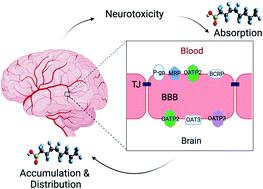当前位置:
X-MOL 学术
›
Environ. Sci.: Processes Impacts
›
论文详情
Our official English website, www.x-mol.net, welcomes your
feedback! (Note: you will need to create a separate account there.)
Absorption, distribution, and toxicity of per- and polyfluoroalkyl substances (PFAS) in the brain: a review
Environmental Science: Processes & Impacts ( IF 4.3 ) Pub Date : 2021-09-10 , DOI: 10.1039/d1em00228g Yuexin Cao 1 , Carla Ng 1, 2
Environmental Science: Processes & Impacts ( IF 4.3 ) Pub Date : 2021-09-10 , DOI: 10.1039/d1em00228g Yuexin Cao 1 , Carla Ng 1, 2
Affiliation

|
Per- and polyfluoroalkyl substances (PFAS) are a class of synthetic chemicals colloquially known as “forever chemicals” because of their high persistence. PFAS have been detected in the blood, liver, kidney, heart, muscle and brain of various species. Although brain is not a dominant tissue for PFAS accumulation compared to blood and liver, adverse effects of PFAS on brain functions have been identified. Here, we review studies related to the absorption, accumulation, distribution and toxicity of PFAS in the brain. We summarize evidence on two potential mechanisms of PFAS entering the brain: initiating blood–brain barrier (BBB) disassembly through disrupting tight junctions and relying on transporters located at the BBB. PFAS with diverse structures and properties enter and accumulate in the brain with varying efficiencies. Compared to long-chain PFAS, short-chain PFAS may not cross cerebral barriers effectively. According to biomonitoring studies and PFAS exposure experiments, PFAS can accumulate in the brain of humans and wildlife species. With respect to the distribution of PFAS in specific brain regions, the brain stem, hippocampus, hypothalamus, pons/medulla and thalamus are dominant for PFAS accumulation. The accumulation and distribution of PFAS in the brain may lead to toxic effects in the central nervous system (CNS), including PFAS-induced behavioral and cognitive disorders. The specific mechanisms underlying such PFAS-induced neurotoxicity remain to be explored, but two major potential mechanisms based on current understanding are PFAS effects on calcium homeostasis and neurotransmitter alterations in neurons. Based on the information available about PFAS uptake, accumulation, distribution and impacts on the brain, PFAS have the potential to enter and accumulate in the brain at varying levels. The balance of existing studies shows there is some indication of risk in animals, while the human evidence is mixed and warrants further scrutiny.
中文翻译:

全氟和多氟烷基物质 (PFAS) 在大脑中的吸收、分布和毒性:综述
全氟和多氟烷基物质 (PFAS) 是一类合成化学品,由于其高度持久性,通俗地称为“永久化学品”。PFAS 已在各种物种的血液、肝脏、肾脏、心脏、肌肉和大脑中检测到。尽管与血液和肝脏相比,大脑不是 PFAS 积累的主要组织,但已经确定了 PFAS 对大脑功能的不利影响。在这里,我们回顾了与全氟和多氟烷基物质在大脑中的吸收、积累、分布和毒性相关的研究。我们总结了 PFAS 进入大脑的两种潜在机制的证据:通过破坏紧密连接和依赖位于 BBB 的转运蛋白来启动血脑屏障 (BBB) 分解。具有不同结构和特性的 PFAS 以不同的效率进入大脑并在大脑中积累。与长链 PFAS 相比,短链 PFAS 可能无法有效穿过脑屏障。根据生物监测研究和 PFAS 暴露实验,PFAS 可以在人类和野生动物物种的大脑中积累。关于PFAS在特定大脑区域的分布,脑干、海马、下丘脑、脑桥/髓质和丘脑是PFAS积累的主要部位。PFAS 在大脑中的积累和分布可能会导致中枢神经系统 (CNS) 的毒性作用,包括 PFAS 引起的行为和认知障碍。这种 PFAS 诱导的神经毒性的具体机制仍有待探索,但基于目前理解的两个主要潜在机制是 PFAS 对钙稳态的影响和神经元中的神经递质改变。根据有关 PFAS 摄取、积累、分布和对大脑影响的可用信息,PFAS 有可能以不同的水平进入大脑并在大脑中积累。现有研究的平衡表明,动物存在一些风险迹象,而人类证据则喜忧参半,需要进一步审查。
更新日期:2021-09-17
中文翻译:

全氟和多氟烷基物质 (PFAS) 在大脑中的吸收、分布和毒性:综述
全氟和多氟烷基物质 (PFAS) 是一类合成化学品,由于其高度持久性,通俗地称为“永久化学品”。PFAS 已在各种物种的血液、肝脏、肾脏、心脏、肌肉和大脑中检测到。尽管与血液和肝脏相比,大脑不是 PFAS 积累的主要组织,但已经确定了 PFAS 对大脑功能的不利影响。在这里,我们回顾了与全氟和多氟烷基物质在大脑中的吸收、积累、分布和毒性相关的研究。我们总结了 PFAS 进入大脑的两种潜在机制的证据:通过破坏紧密连接和依赖位于 BBB 的转运蛋白来启动血脑屏障 (BBB) 分解。具有不同结构和特性的 PFAS 以不同的效率进入大脑并在大脑中积累。与长链 PFAS 相比,短链 PFAS 可能无法有效穿过脑屏障。根据生物监测研究和 PFAS 暴露实验,PFAS 可以在人类和野生动物物种的大脑中积累。关于PFAS在特定大脑区域的分布,脑干、海马、下丘脑、脑桥/髓质和丘脑是PFAS积累的主要部位。PFAS 在大脑中的积累和分布可能会导致中枢神经系统 (CNS) 的毒性作用,包括 PFAS 引起的行为和认知障碍。这种 PFAS 诱导的神经毒性的具体机制仍有待探索,但基于目前理解的两个主要潜在机制是 PFAS 对钙稳态的影响和神经元中的神经递质改变。根据有关 PFAS 摄取、积累、分布和对大脑影响的可用信息,PFAS 有可能以不同的水平进入大脑并在大脑中积累。现有研究的平衡表明,动物存在一些风险迹象,而人类证据则喜忧参半,需要进一步审查。











































 京公网安备 11010802027423号
京公网安备 11010802027423号